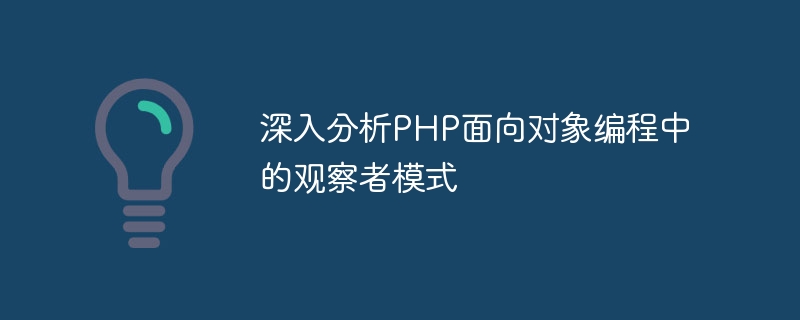

In-depth analysis of the observer pattern in PHP object-oriented programming
The observer pattern is a commonly used design pattern used to implement objects between objects in software systems of loose coupling. Its core idea is: an object (called an observer or subject) maintains a list of objects (called observers) that depend on it. When the state of the observed object changes, it will automatically notify all observers. . In this way, the observer pattern can realize a one-to-many relationship between objects. When an object changes, all related objects will be notified and can respond in time.
In the popular PHP object-oriented programming, the observer pattern is widely used to implement event-driven systems, messaging systems, and subscription and publishing systems. Below, we will deeply analyze the implementation of the observer pattern in PHP object-oriented programming and provide some code examples.
First, we define the subject interface, which contains the following methods:
interface Subject
{
public function attach(Observer $observer);
public function detach(Observer $observer);
public function notify();
}In this interface, we define three methods: attach is used to subscribe to observers, and detach is used to subscribe to observers. For unsubscribing observers, notify is used to notify all observers. Next, we implement a specific topic class:
class ConcreteSubject implements Subject
{
private $observers = [];
private $state;
public function attach(Observer $observer)
{
$this->observers[] = $observer;
}
public function detach(Observer $observer)
{
foreach ($this->observers as $key => $obs) {
if ($obs === $observer) {
unset($this->observers[$key]);
}
}
}
public function notify()
{
foreach ($this->observers as $observer) {
$observer->update();
}
}
public function getState()
{
return $this->state;
}
public function setState($state)
{
$this->state = $state;
$this->notify();
}
}In this specific topic class, we maintain an observer list and a state. Through the attach method, we can add observers to the list; through the detach method, we can remove observers from the list; through the notify method, we can notify all observers. When the state of the topic changes, we call the setState method to update the state and notify all observers subscribed to the topic.
Next, we define the Observer interface:
interface Observer
{
public function update();
}In this interface, we define a method update, which is used to do when the state of the observed changes. respond. Next, we implement a specific observer class:
class ConcreteObserver implements Observer
{
private $subject;
private $state;
public function __construct(Subject $subject)
{
$this->subject = $subject;
$this->subject->attach($this);
}
public function update()
{
$this->state = $this->subject->getState();
echo "Observer state updated: " . $this->state . "
";
}
public function getState()
{
return $this->state;
}
}In this specific observer class, we add the observer to the subject's observer list through the constructor method, and obtain the observer in the update method. Observer's state and perform some response operations.
Finally, we can write a test code to verify how the observer pattern works:
$subject = new ConcreteSubject(); $observer1 = new ConcreteObserver($subject); $observer2 = new ConcreteObserver($subject); $subject->setState(1); // 输出:Observer state updated: 1 $subject->setState(2); // 输出:Observer state updated: 2
In the above test code, we create a specific subject object and two specific observer objects , and adds the observer object to the subject object's observer list. Then, the observer's state update is triggered by setting the state of the subject object, and the updated state is output.
Through the above analysis and code examples, we have an in-depth understanding of the implementation of the observer pattern in PHP object-oriented programming. The observer pattern can help us achieve loose coupling between objects and make the system more flexible and scalable. In actual development, we can reasonably apply the observer pattern according to specific needs to improve the design quality and development efficiency of software systems.
The above is the detailed content of In-depth analysis of the observer pattern in PHP object-oriented programming. For more information, please follow other related articles on the PHP Chinese website!